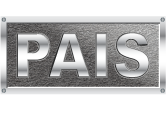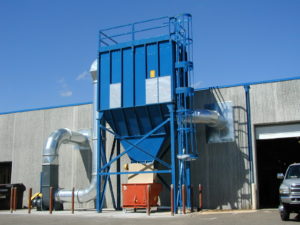
Industrial and commercial processing plants use dust collectors to capture airborne particulate (dust and other impurities from air or gas). Industrial duct collectors play a crucial role in keeping employees and their working environments as safe as possible and meeting regulatory compliance. Dust collector systems consist of a blower, dust filter, a filter-cleaning system, and a dust receptacle or dust removal system.
There are five main types of industrial dust collectors—inertial separators, fabric filters, wet scrubbers, unit collectors, and electrostatic precipitators. Dust collectors vary widely in design, operation, effectiveness, space requirements, construction, and capital, operating, and maintenance costs. Each type has advantages and disadvantages, depending on a variety of factors including dust concentration and particle size, the degree of dust collection required, characteristics of dust particles and airstream, and methods of disposal.
A poorly performing dust collector can be the result of high dust loading, lack of cleaning, or a combination of the two.
Here are eight tips to make sure your dust collector is properly maintained.
1. Use the Right Parts
Make sure your dust collector system is using the right parts, from the blower, dust filter, a filter-cleaning system, dust receptacle or dust removal system, to cartridges and baghouse solenoids, fans and valves. Each part plays a role to ensure the collector is operating at design point. We recommend using factory recommended replacement parts and be leery of less expensive alternatives.
2. Is Your Hopper Free of Dust?
A duct collector’s hopper should never be used to store dust. The hopper is intended to funnel process dust to a storage bin. Dust accumulating in a hopper creates a potential fire or deflagration risk. Dust in your hopper will also clog the system and diminish the collector’s performance and prevent the pulse-cleaning from doing its job.
3. Check Diaphragm Valves
It’s smart to make checking your diaphragm valves a priority each year. Particularly when new baghouses or cartridges are installed, it is recommended to check the valves and ensure that all filters are cleaned properly from the beginning. Remember that it’s always cheaper to replace diaphragm valves that it is to buy new filters because of inadequate pulsing. (Remember to wear appropriate ear protection when testing pulse valves as the noise level can rise considerably.)
4. Regularly Check Your Ductwork
The National Fire Protection Association requires protection for the ductwork and safety processes upstream of the dust collector. It’s smart to equip your ducting with a flow-activated isolation valve protecting downstream work areas from the propagation of flame and pressure through the inlet duct when deflagration occurs in a dust collector. If there is deflagration in a dust collector, the pressure will close the valve preventing the passage of flame and smoke to areas upstream from the valve. The valve latches shut and must be reopened manually. Some parts of the valve may be damaged, and a thorough inspection is required before the valve is back in service.
5. Make Sure You’re Using the Correct Air Pressure in Your Dust Collector
Compressed air pressure is crucial for the performance and longevity of a dust When compressed air is too low, filter cartridges are not properly cleaned which results in rapid downgrade and saturation. When air pressure is too high, filter cartridges are used up faster and need to be replaced more frequently, driving up cost and maintenance. It’s very important to always have your compressed air pressure within the limits of manufacturers recommendations. Your compressed air should be oil and water free, and the amount should be sufficient for all users performing simultaneous tasks.
6. Keep an Eye on Pressure Drop
Increasing pressure drop (typically measured in inches of water column)across the dust collector affects the ability of the collection system to capture dust. As a safety measure, change filters when airflow reaches a differential pressure. New filters have the lowest pressure drop because of the inherent permeability of the media. As the bags develop dust, some particulate embeds itself into the filter media, which increases the pressure drop.
7. Create an Inspection or Maintenance Program
Dust collectors have allowed companies to effectively capture airborne particulate which helps provide a healthy and clean work environment. To ensure a dust collector is working properly, periodic inspections and a maintenance program will go a long way toward keeping your dust collector functioning at a high level. Scheduled inspections on a daily, weekly, monthly, semi-annual and annual basis will keep your dust collector working efficiently and keep your maintenance costs down. Failing to routinely inspect and maintain your dust collector can hurt its performance, and continued neglect will lead to your dust collector not meeting EPA outlet emissions standards. Partner professional trained outside firm like P-A Industrial Services to help ensure that the maintenance is executed properly and your internal staff is trained.
8. Inspect the Filter Media
To optimize your dust collector’s performance; you should inspect your filter media often. The filter is the most important part of a dust collector because it accumulates and supports dust cake. Dust cake is what provides high filtering efficiencies during operation. Regularly inspect the clean-air side of the dust collector for leaks and the bags for tears. If pressure drop within a dust collector becomes extremely high compared to normal, it may be caused by excessive dust cake or “blinding” of the filter bags.
Most importantly in the maintenance of your dust collector—always practice safety! Unless something goes wrong, workers should never have to enter the dust collector to change the filters. Filters should be positioned for easy access and slide in and out of the housing easily. It’s also a good idea to add a safety monitoring filter to your collector. A secondary filter can prevent dust from re-entering the workspace if there is a leak in the dust collector’s primary filters.
The importance of having a quality dust collection system in a production facility can’t be understated. You’re not only providing a clean and compliant work environment for your employees—you’re supporting the overall effectiveness of your operational efficiencies. With over 100 years of combined industry experience, P-A Industrial Services provides equipment, parts, and services all over the United States for businesses of all sizes. Our industry experience allows us to inspect, maintain, or repair all equipment components in your dust collection system to make sure you’re operating at the highest efficiencies. Similarly, we can evaluate system performance and make recommendations for improved productivity. P-A Industrial Services will make sure you’re using the right parts—from air compressors, blowers, filters, dust receptacles to cartridges, fans, and valves.
Give us a call at (612) 330-0150 or contact us to see how we can help you get your production facility operating at its highest efficiency.

